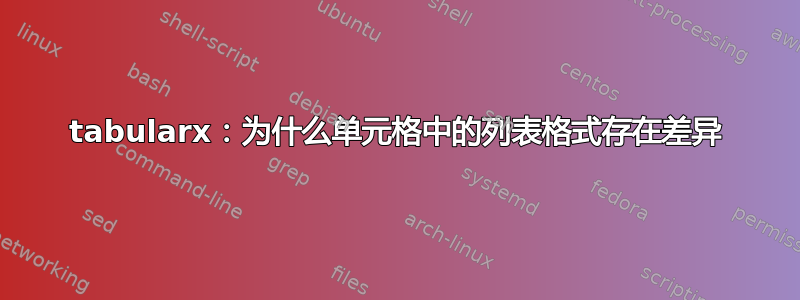
请考虑姆韦吼叫:
\documentclass[11pt,a4paper]{report}
\usepackage[margin=2.5cm]{geometry}
\usepackage[english]{babel}
\usepackage{ragged2e}
\usepackage{booktabs, tabularx}
\newcolumntype{L}{>{\RaggedRight\hspace{0pt}}X}
\usepackage{enumitem}
\usepackage{etoolbox}
\AtBeginEnvironment{table}{%
\setlist[itemize]{nosep,
wide,%leftmargin = *,
before = \vspace{-\baselineskip},
after = \vspace{-\baselineskip}
}
}% end of AtBeginEnvironment
%-------------------------------- show page layout, only for test
\usepackage{showframe}
\renewcommand\ShowFrameLinethickness{0.15pt}
\renewcommand*\ShowFrameColor{\color{red}}
%---------------------------------------------------------------%
\begin{document}
\begin{table}[htbp]
\small
\begin{tabularx}{\linewidth}{@{} p{15mm} L L L
@{}}
\toprule
&
Integration of heterogeneous data &
Algorithms to identify urban features &
Improve accuracy for spectral classification algorithms \\
\midrule
Objective &
\begin{itemize}
\item Improve the spatial and spectral resolution
\item Enhance the ability of features detection and display
\item Promote the geometric precision
\end{itemize}
&
\begin{itemize}
\item Accelerate future processing and improve classification accuracy
\item Automated processes for detecting, extracting, simulating, classifying and modelling urban features
\end{itemize}
&
\begin{itemize}
\item Capability of separating urban land-cover and land-use classes in an adequate manner
\end{itemize} \\
\bottomrule
\end{tabularx}
\end{table}
\begin{table}[htbp]
\small
\begin{tabularx}{\linewidth}{@{} >{\hsize=0.4\hsize}L
*{3}{>{\hsize=1.2\hsize}L}
@{}}
\toprule
&
Integration of heterogeneous data &
Algorithms to identify urban features &
Improve accuracy for spectral classification algorithms \\
\midrule
Objective &
\begin{itemize}
\item Improve the spatial and spectral resolution
\item Enhance the ability of features detection and display
\item Promote the geometric precision
\end{itemize}
&
\begin{itemize}
\item Accelerate future processing and improve classification accuracy
\item Automated processes for detecting, extracting, simulating, classifying and modelling urban features
\end{itemize}
&
\begin{itemize}
\item Capability of separating urban land-cover and land-use classes in an adequate manner
\end{itemize} \\
\bottomrule
\end{tabularx}
\end{table}
\end{document}
我们可以看到,在两种情况下,列的宽度是相同的。为什么列表的格式不同?
答案1
直接设置\hsize当然不是乳胶支持的事情,这意味着任何嵌套列表结构都不知道它应该有多宽,设置\linewidth为新的\hsize可以让事情回到正轨。
文档tabularx也许应该记录这一点,尽管它确实记录了所有X列必须具有相同的宽度,除非你违反规则.....
\documentclass[11pt,a4paper]{report}
\usepackage[margin=2.5cm]{geometry}
\usepackage[english]{babel}
\usepackage{ragged2e}
\usepackage{booktabs, tabularx}
\newcolumntype{L}{>{\RaggedRight\hspace{0pt}}X}
\usepackage{enumitem}
\usepackage{etoolbox}
\AtBeginEnvironment{table}{%
\setlist[itemize]{nosep,
wide,%leftmargin = *,
before = \vspace{-\baselineskip},
after = \vspace{-\baselineskip}
}
}% end of AtBeginEnvironment
%-------------------------------- show page layout, only for test
\usepackage{showframe}
\renewcommand\ShowFrameLinethickness{0.15pt}
\renewcommand*\ShowFrameColor{\color{red}}
%---------------------------------------------------------------%
\begin{document}
\begin{table}[htbp]
\small
\begin{tabularx}{\linewidth}{@{} p{15mm} L L L
@{}}
\toprule
&
Integration of heterogeneous data &
Algorithms to identify urban features &
Improve accuracy for spectral classification algorithms \\
\midrule
Objective &
\begin{itemize}
\item Improve the spatial and spectral resolution
\item Enhance the ability of features detection and display
\item Promote the geometric precision
\end{itemize}
&
\begin{itemize}
\item Accelerate future processing and improve classification accuracy
\item Automated processes for detecting, extracting, simulating, classifying and modelling urban features
\end{itemize}
&
\begin{itemize}
\item Capability of separating urban land-cover and land-use classes in an adequate manner
\end{itemize} \\
\bottomrule
\end{tabularx}
\end{table}
\begin{table}[htbp]
\small
\begin{tabularx}{\linewidth}{@{} >{\hsize=0.4\hsize\linewidth=\hsize}L
*{3}{>{\hsize=1.2\hsize\linewidth=\hsize}L}
@{}}
\toprule
&
Integration of heterogeneous data &
Algorithms to identify urban features &
Improve accuracy for spectral classification algorithms \\
\midrule
Objective &
\begin{itemize}
\item Improve the spatial and spectral resolution
\item Enhance the ability of features detection and display
\item Promote the geometric precision
\end{itemize}
&
\begin{itemize}
\item Accelerate future processing and improve classification accuracy
\item Automated processes for detecting, extracting, simulating, classifying and modelling urban features
\end{itemize}
&
\begin{itemize}
\item Capability of separating urban land-cover and land-use classes in an adequate manner
\end{itemize} \\
\bottomrule
\end{tabularx}
\end{table}
\end{document}
为了获得完全相同的换行符,您可以使用
\begin{tabularx}{\linewidth}{@{} >{\hsize=.406\hsize\linewidth=\hsize}L
*{3}{>{\hsize=1.198\hsize\linewidth=\hsize}L}
@{}}




